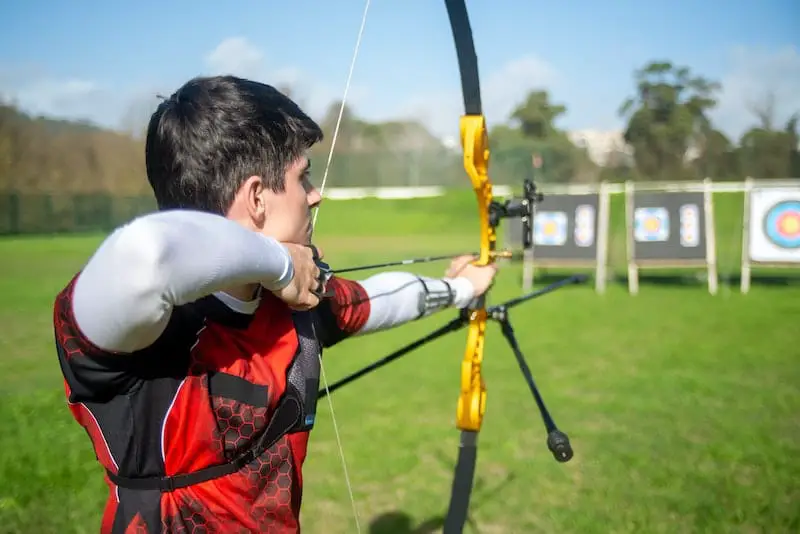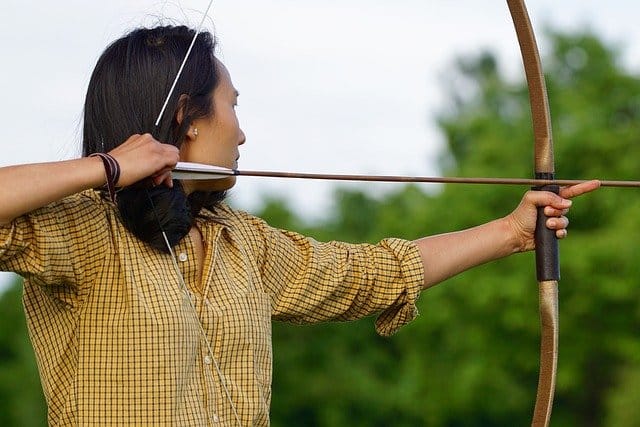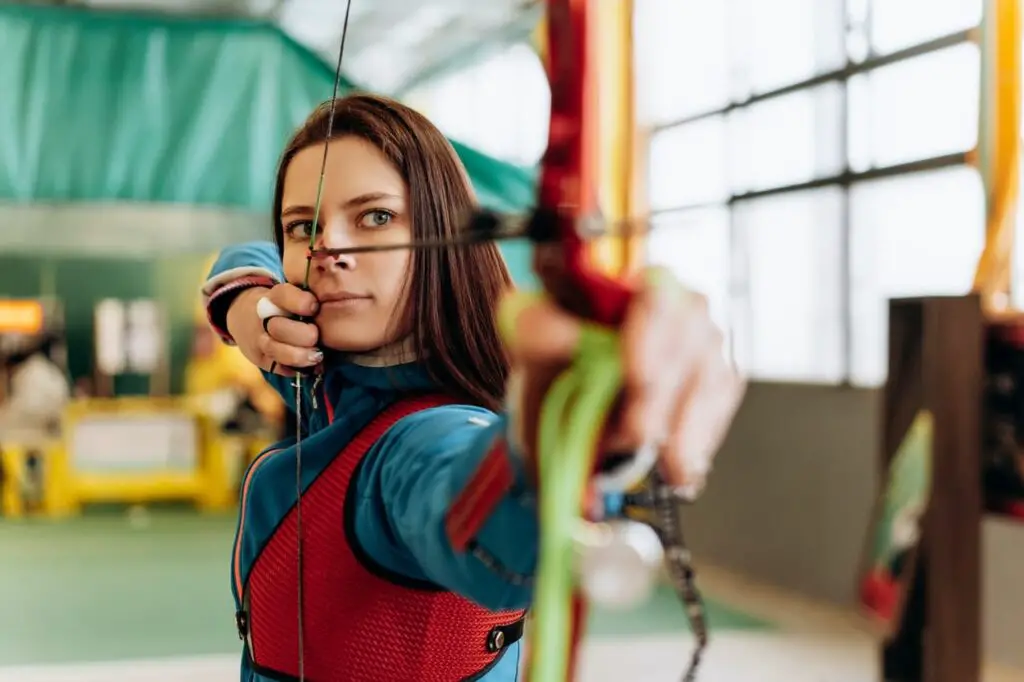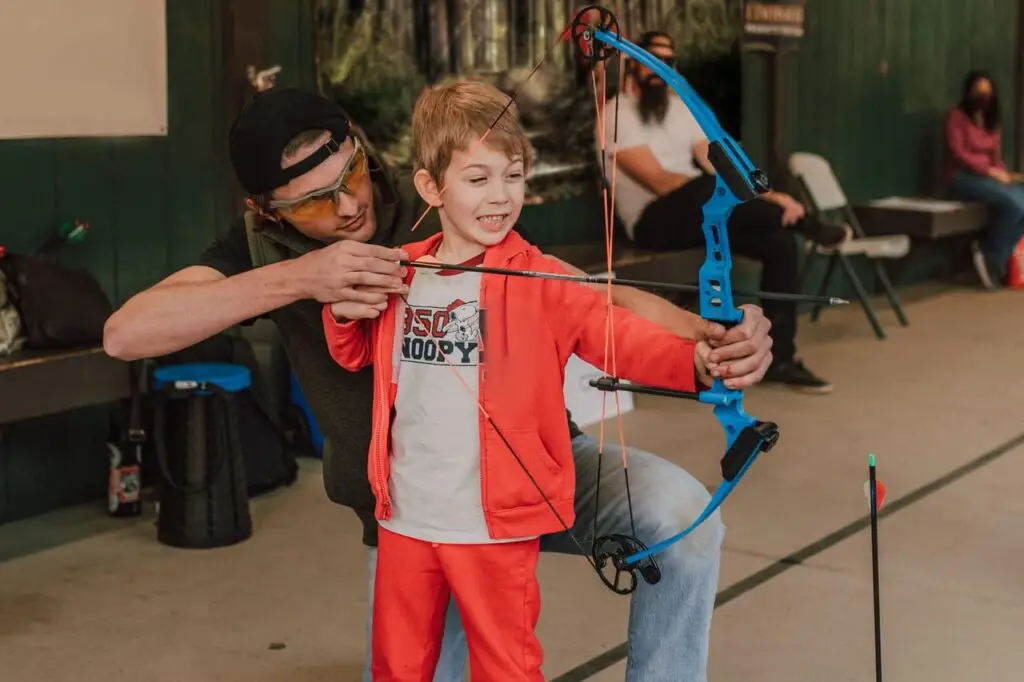Competitive archery can be a great way to meet new people, have fun, and compete. Competitive archery usually involves shooting at targets from set distances or knocking down objects in an indicated zone or order.
Getting into competitive archery can be intimidating for beginner archers if they don’t know the steps. This guide will provide a complete breakdown of how to get into competitive archery, from what you need and where to look for opportunities.

Are There Requirements to Get into Competitive Archery?
Becoming a competitive archer requires a lot of patience and practice (but does it also require a lot of strength?). Archery is not something you can just show up one day and do well at without practicing beforehand.
Though there aren’t any requirements to get started in competitive archery, there are still some basic things you will need before joining a club or team. Those include a base level knowledge of the sport and the willpower to practice and improve.
Some additional items that you should have or at least be prepared to learn and perfect include:
- Strong Arm/Wrist Strength – To shoot an arrow accurately, your arm needs to have enough strength behind it to hold your bow straight for the full draw. If your arm isn’t strong enough, the bow will start to turn down at one end or the other and get off target.
- Good Form – Even if you have a lot of arm strength, it won’t do much good unless you can hold your bow still while drawing and aiming. You need to be able to keep a tight grip on your bow while making sure it doesn’t move side-to-side or up & down. This usually takes a bit of strength in your back/chest muscles and some practice with proper form.
- Patience – Archery is not an instant skill that everyone can pick up with ease. Just like any sport, becoming proficient at archery takes time and effort. If you anticipate great results right away, you will be disappointed with the results and quit before starting to improve.
Also, even if you’re patient and practice regularly, it can still take a long time to get good enough to compete in competitions. It is not something that most people do for fun occasionally; instead, it takes dedication and focus over a period of years to become skilled enough to compete on a level playing field against other archers your age/skill level.
How Do I Get into Competitive Archery?
Many schools sponsor archery clubs or teams for students over 18 years old. College-level sports are an easy way to become involved in competitive archery without having any prior experience. In addition, these clubs can be a great place to meet new people and have fun while improving your archery skills.
To start getting into competitive archery, look for programs or clubs at local schools and colleges. Additionally, you can look to your community for archery clubs and competitions. Again, there are various methods of getting started.
In addition to schools and clubs, you can look to get started in competitive archery by checking out:
- Local Sports/Archery Club – Does your town have an archery club nearby? Frequently this is an excellent place to start because there’s no pressure since it’s not for competition. Most clubs will welcome all ages, particularly if there are few members in the area.
- Facebook Pages – This is a good networking site if you already have friends or relatives who are archers, but it’s also reasonably easy to make new ones on Facebook. Join local pages, which are for people with similar interests, and ask around there about where to find information about competitive archery.
- 4-H Clubs – The FFA isn’t the only agricultural club involved in archery. Many 4-H clubs support students interested in various forms of competition, including archery, so this is another good place to look for local opportunities in your area where they might host events or even sponsor teams.
- Hire a teacher – Get a personal coach or teacher to teach you how to be the best archer that you can be.
Does an archery teacher have to be certified to teach archery?
Scouting camps also offer sports programs that can be used by competitive archers, particularly the BSA Camp programs. These are generally well-organized and always looking for new scouts to join their ranks, so this is an easy way to make friends who share your interests.
What Equipment Do I Need for Competitive Archery?
Gaining access to competitive archery requires a bit more than just having the willpower to practice every day. In addition to your dedication, you need specialized equipment that is appropriate for competitive archery.
The necessary equipment to be in competitive archery includes:
- A quality bow
- Arrow rest
- Arrow sling
- Sights, and
- Protective safety equipment
There are multiple types of bows to use for competitive archery, but a good rule of thumb is to determine the length of the draw and divide by 2.5 to estimate how much weight you can pull without having problems with the form or potential injury. If it’s a competition, here are a few other things to keep in mind as far as equipment is concerned:
- Compound Bows vs. Recurve Bows – These days, most competitive archers use compound bows (or crossbows); these shoot more quickly & accurately than recurves because they have additional pulleys, which give a mechanical advantage to the archer based on draw weight (explained: difference between a compound bow and a recurve bow).
- Arrow Rest – The purpose of an arrow rest is to keep your arrows from falling off the bow while you’re drawing it back. This keeps them stable, so they fly in roughly the direction you want them to go when you let them loose, but it isn’t foolproof since wind & other factors will affect their flight path.
- Archery Sling – This is used to steady your aim by taking the weight of your bow off of your arms & shoulders. Some archers will use this for every shot, while others prefer to shoot without it occasionally to avoid developing bad habits.
- Quiver – This holds arrows for when you need them during a competition (or practice). Some quivers attach directly to the bow, and others clip onto a belt or other piece of equipment (i.e., bow sling). Ask around and get opinions before making your purchase.
- Bow Sight – The sight helps you aim more accurately than just “eyeballing” it because it gives you visual feedback about how to adjust your form based on where you’re aiming. Since this piece of equipment can get reasonably expensive (depending on the type & quality), ask around for recommendations before purchasing one yourself.
If you don’t want blisters on your hands, invest in some finger protection that goes over the part of the bowstring that makes contact with your fingers when drawing it back. The best option is usually leather or suede; these are tough enough to stand up against constant wear but not too thick or rigid where they might interfere when knocking an arrow. Some additional protective equipment to look into includes:
- Chest Protector – Accidents can happen if somebody is shooting poorly or just isn’t very good at judging distances/accuracy. A chest protector provides as much as a centimeter of padding, which will hopefully prevent injury if your opponent sends one your way by accident.
- Eye Protection – If you have glasses, get some specially made shooting glasses. These are even more shatterproof/resistant than regular eyeglasses, so they’ll be able to stand up against the abuse of shooting thousands of arrows over time. This is probably the most critical piece of equipment; bifocals and other corrective lenses (even contacts) can fail in a split second and put you at serious risk in an archery competition when speed & accuracy matter most!
How long do archery arrows last?
How to Get Started as a Beginner Competitive Archer
Getting started as a competitive archer can be a challenging task, especially as a beginner, but following some simple steps will have you competing in no time!
Find a Club or Club Team
Some students shoot recreationally after school, but if you’re interested in competing, then look into joining a club team (or start your own) through your school’s archery club, intramural/extracurricular activities, or with USA Archery. There are three different divisions in competitive archery: recurve, barebow & compound.
Get a Quality Bow and Arrows
Beginners should look for something adjustable and easy to handle without too many extras (like sights and stabilizers, which add weight and make it harder to shoot; these become more important as you progress).
For most competition purposes, it’s best to go with a traditional longbow or recurve bow (explained: difference between recurve bow and composite bow), but if you want more power/distance than traditional bows will provide, then research what types of bows would work best for you.
Quality comes at a price with arrows, so if you want something that isn’t too expensive (and won’t break down after just a few months), then research carbon fiber shafts vs. aluminum alloy. Many archers recommend carbon for beginners because it is lighter which makes it easier to shoot accurately without fatiguing your muscles as much.
Learn about Shaft Weight and String Material
Shaft weight is measured in “grains,” There are 7,000 grains to a pound. This number can be misleading because the length of the arrow also affects how heavy it feels/how powerful it will be, so it’s best to ask someone who already shoots what they’re using before purchasing one yourself.
For recurve bows, most archers use a combination of different materials for the string (cotton, mohair, linen), while some stick with just one. So again, it’s best to find out what other people have been using and try a few different kinds before deciding which you prefer.
Invest in Solid Equipment and Add Accessories
Once you know what equipment you’ll need for your specific type of bow, then add accessories like finger slings, bow stringer & armguard(s) on top of anything else that might be needed depending on how long/often you shoot. Finger slings help protect your fingers from being hit by an arrow when drawing back the bowstring, so they’re worth having!
Since competitive archery can get fairly expensive, it’s best to purchase more affordable equipment that will be able to hold up for a while (vital if you’re shooting thousands of arrows per year). Ensure that the World Archery Federation approves your equipment before using/purchasing it.
Are archery releases expensive?
Join a Competition
Whether through your school, club or somewhere else entirely it’s always possible to find local competitions in your area which are great ways to meet other people with similar interests and join different groups.
Archery is quite versatile, so keep an open mind about trying new things! There are many different types of bows & accessories out there that can help you progress faster depending on what you’re interested in.
How to Train for Competitive Archery
If you want to get into competitive archery – and maybe go for a spot at the Olympics – you should join a club. Once you’ve found a club/group to join, find out about their training schedule and create your own that will work alongside it. This means practicing when you can but also making sure that your body is ready for competitive archery by eating right & getting enough sleep throughout the week!
You could also set up an indoor archery range at home to train even more when your club is closed.
Some training tips for competitive archery include:
- Practice Daily – Take 5-20 minutes each day to practice so that shooting feels like second nature. In addition to simply drawing back the bowstring, shooting arrows at different targets & heights is essential so try mixing them up if possible.
- Improve Your Draw Length – Don’t be discouraged if you feel like your draw length isn’t where it needs to be. There are ways to practice this, making it easier to compete with a longer draw length.
- Practice Right Before Competitions – Before competing, always make sure you warm up; otherwise, your muscles might cramp, or you’ll experience decreased performance! Stretch & aim at the target for about 10 minutes before shooting your first arrow of the competition.
During competitions, even if your arrows are “close,” that’s not good enough because all points are taken into consideration no matter how far away they are from the center/bullseye. So, even if you’re only half an inch off, then you’ll receive fewer points than someone who was right on, and that can be a considerable difference when narrowing down the winner. Practice is key to perfection!
Final Thoughts
Competitive archery can be an excellent way for beginner and advanced competitive archers to get exercise, meet new people, compete, or just have fun. The benefits of getting into this sport are endless.
The competitive archery community has many opportunities for beginner archers who are looking to get started or hone their skills.


